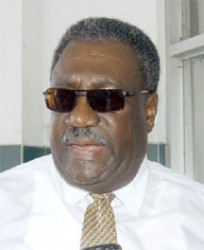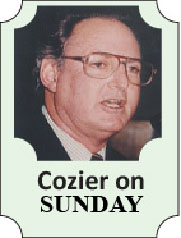Clive Lloyd leaves no doubt over where he stands on Twenty20 cricket.
As West Indies were trounced by an innings inside three days in the two Tendulkar Farewell Tests in India in November 2013, the captain through the glory days of the 1980s commented that they “looked drunk on Twenty20”.
Last week, as new chairman of selectors, Lloyd contended that Twenty20 had “messed up West Indies cricket”. Playing Tests for West Indies, he said, no longer seemed a paramount goal for players.
There are obvious reasons.
Players can read the certain signs that Test cricket for the West Indies is in its last throes, a condition evident in the results over the past two decades and in the markedly dwindling attendances. The upshot is that they regard Twenty20 as the game of the future.
For some, if not all, it is also undoubtedly a matter of money and how much of it they can make in the two vastly different versions.
For others, it is a response to their pigeon-holing as limited-overs specialists by previous selection panels.
Certainly, Keiron Pollard, who is yet to be picked for Tests seven years after his first-class debut, has repeatedly pleaded for an opportunity to test himself at that level; now 27, he is unlikely to get it.
The same holds true for Dwayne Bravo, Dwayne Smith and others who have come to acknowledge that their futures are in the shortest format.
Bravo’s last of his 40 Tests was nearly five years ago; he is now even shut out from ODIs as he is made to pay the price for his part in the team’s withdrawal from the tour of India in October.
Smith dazzled with a hundred on Test debut in South Africa, aged 20; he has had nine Tests since, the last in 2006. Three weeks ago, he retired from first-class cricket.

They and the others confined to short-format cricket were all back in the maroon kit at Newlands in Cape Town on Friday, contributing to the West Indies victory over South Africa in the first of three Twenty20 Internationals.
The home team was below top strength, minus Hamish Amla, AB deVilliers, Dale Steyn, Vernon Philander and Morne Morkel, yet there was a certain confidence to the West Indies’ performance missing in the Tests.
Not for nothing does Faf duPlessis, South Africa’s short-format captain, rate them the strongest of Twenty20 teams. They carry explosive power-hitters and sharp, sure-handed fielders, both critical in matches abbreviated to 20 overs an innings.
Chris Gayle, whose Test credentials were established well before the advent of Twenty20, has become the new game’s most devastating batsman. As much as his 77 off 31 balls in Friday’s win was typical, it could have just as well come from the bats of any one of Pollard, Smith, Marlon Samuels or Andre Russell.
Russell was one of the seven West Indians not engaged in the preceding Test series; Lloyd cited him as an example of his concerns about the effects of Twenty20 cricket.
He described Russell as “one of the best all-rounders in the world”. Instead of aspiring to Test cricket, he said Russell advised him he could only play one-day cricket because of a knee problem.
Lloyd’s lament was that it was “such a waste that we have a guy who could be a great cricketer who is now not thinking of playing both formats.”
Russell’s one and only Test was in Sri Lanka just over four years ago. He is an exceptional athlete, with his Jamaican speed and outstanding work in the outfield, a bowler of lively pace and as potentially destructive a hitter as any.
His presence in the Tests in South Africa would have made a difference to the shoddy fielding and the collapsible West Indies lower order (7-44, 6-39, 7-44 and 7-33 in successive innings). His bowling would not have been out of place either.
He has clearly given up on a recall to the Test team; lucrative contracts in the Indian Premier League (IPL) where he is driven by the adrenalin rush of large, appreciative crowds are now his game.
Of the dozen West Indians engaged in the IPL last year, only five – Chris Gayle, Ravi Rampaul, Darren Sammy and Sunil Narine – had played Test cricket. Jason Holder joined them a few weeks later.
Sammy has since quit Tests. Rampaul hasn’t played one for two years and wasn’t even among the 30 provisionally named for the imminent World Cup. Narine disqualified himself from selection for the home series against New Zealand last June by remaining in India for the IPL final.
Their pride in representing the West Indies now comes in the spasmodic Twenty20s, such as the three in South Africa. They have become gifted at it, primarily through their experience competing against the best of the best in the IPL and other global Twenty20 tournaments.
So it was with English county cricket in Lloyd’s time. It was there that he and his fellow West Indians skillfully adapted to the intricacies of the limited-overs game, then between 40 and 60 overs an innings and as unfamiliar as Twenty20 was at the start. All 11 in the victorious team in the final of the inaugural World Cup in 1975 were with county teams.
County cricket also polished their natural talent. World Series Cricket in Australia and the cutthroat rivalry of the Regional Shell Shield made them mentally tough. The consequence was their unrivaled dominance through the 1980s.
The IPL, along with the Big Bash, Ram Slam and other bizarrely titled contests, has had the same effect on Twenty20 West Indians. Now that their equivalent, the Caribbean Premier League (CPL), has landed on our doorstep carrying a host of identifiable international stars, a new generation of Gayles, Pollards and the like can be expected.
In the meantime, it is unlikely that worthy Test cricketers can be developed from an annual first-class competition weakened by sub-standard pitches and the simultaneous absence of the best players, away on West Indies’ duty or with Twenty20 franchises, and dominated by spinners and embarrassingly small scores.
The introduction of the West Indies Cricket Board’s Professional Cricket League (PCL), the contracting of 90 full-time professionals for the first time and the expansion of the season from one round to two will take time to make a difference. And all the symptoms imply that West Indies’ Test cricket has little time left.






